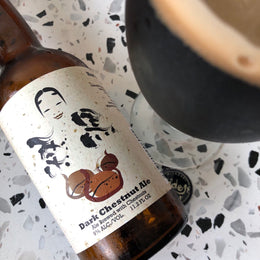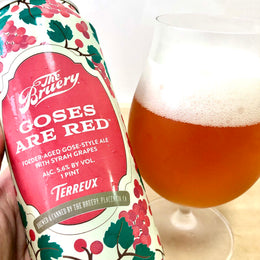We Tasted And Ranked Every Chimay Trappist Beer: Gold, Red, Triple (White), Blue And Green - Which Colour Won?

In the little niche of the beer world that is monastic Trappist ales - really just about 11 breweries worldwide - Chimay certainly stands out as being the most aesthetic. Each expression is given its own very striking and yet somehow understatedly elegant colour code - it's simple but does the job perfectly well in telling you what's what, and at the same time immediately spurs compulsions to amass all of them and try them in a flight in a bid to figure out which colour is the one for you, or really just an excuse handed to you to drink five ales at once.
So who is Chimay?


The Scourmont Abbey.
Chimay, or Brasserie de Chimay, belongs to the Scourmont Abbey, a Trappist monastery in Chimay, Hainaut, Belgium, right along the border with France - that is west Belgium. Scourmont Abbey itself marks the start of its story as 1844, when Jean-Baptiste Jourdain, a priest in the small village of Virelles, had succeeded in convincing the Prince of Chimay to allow for a monastic Cistercian abbey to be built in a clearing in Scourmont. This was a win-win for the Prince who thought it a good idea, where the land that was left barren (as the once iron town had now been left abandoned as folks left for the coal mines to the east) could instead be cleared and cultivated, thereby rejuvenating the otherwise impoverished area. With the Prince's approval in hand and quite a bit of convincing of the existing larger Trappist abbeys (Westmalle turned down the offer, as did Westvleteren initially, yet eventually caved as their abbey was overpopulated with monks), 17 monks from the Saint-Sixte abbey in Westvleteren (massively famous and cult like for its label-less, highly sought after Trappist ales) would thus set off to establish the Scourmont Abbey in Chimay.

Now, alittle abit about these Trappist monks and why it is that they have a penchant for making incredibly great ales, it's worth first knowing that Trappist monks and abbeys belong to the religious order of La Trappe, so named after the La Trappe Abbey in Normandy where a congregation of monks had settled upon after they had broken away from the Catholic Cistercian order, and had thus hoped to bring about reforms that would call for a stricter order of religious practices. Yet when the French Revolution swept over, the Trappists monks would find themselves fleeing to Belgium, where they would regroup in the form of several monastic abbeys. Core to their religious practice is the tenet of Ora et Labora, that is to praise and seek God, whilst also committing their life to labour - and it so happens that this labour comes in the form of beermaking! As such, Trappist abbeys are known for engaging in producing various agricultural goods such as beers, cheeses, chocolates and even knitwear made of wool. However, it must clarified that in order for these goods to be deemed "Trappist", the abbey must abide by a strict rule of using the proceeds from the sale of these goods for only to pay for the abbey's expenses in order to allow for the monks to pursue their monastic practice, and then any surplus must thus be donated to charities or social efforts. And thus whilst Trappist ales have really taken off worldwide, and have been a great success, these abbeys do not directly profit from it.

Chimay's famed cows.
Nevertheless getting back to the Scourmont Abbey (so named after the Scourmont Plateau that the abbey is located upon, and initially going by Notre Dame de St Joseph à Forges, after the patron saint of the Prince of Chimay), things didn't quite go according to plan and setting up the monastery in the marshlands interspersed by hilly terrain just outside of Chimay was way more difficult than expected, with the weather terribly cold, and worse yet the monks had also begun to lack the financial means needed to realise the abbey. This led to the acquiring of 50 cows of pure Dutch breed, which allowed them to begin producing butter, cheese and dairy (of which a particular monk, Brother Benoit, had even journeyed to France to learn cheesemaking, resulting in a special Chimay Trappist cheese that was created!), which turned out to be quite the hit! Encouraged by the great response to their quality produce, the monks would expand their activities to making beers, even being pioneers in using then state of the art steam engines to power the brewery.
By 1862, the brewery was up and running, and interestingly enough it's first beer was in fact a Doppelbock (a bottom-fermented dark lager that is the opposite of the more traditional Belgian top-fermented ale)! This was as the first brewing run was done by the laypeople hired by the monks to set up the brewery, and thus the constructors simply made a beer whose recipe they were familiar with. Once the monks got on the brewing action themselves, they reverted back to the more classic Belgian style of producing top-fermented ales, where they uniquely had a second re-fermentation happen in bottle as they had wanted to produce an ale that could age well, and would continue to develop for years to come in the bottle - almost akin to wine! Much like its spectacular cheeses, Chimay's ales would also become a huge hit, and was even marketed as being a health tonic.

Professor Jean DeClerck.
Unfortunately the turn of the millennium had not been kind to the abbey - World War I would have the brewery stripped bare as German soldiers had sought out any and all copper they could find, which inevitably meant that all brewing equipment was gone. And before the monks could finish rebuilding the abbey, World War II would break out. Yet if there were any silver lining to all of this, as the monks would have to start all over again on a blank slate, this gave them the opportunity to be completely focused on how they wanted to approach beer brewing. Rather than the somewhat haphazard and piecemeal accumulation of brewing practices that had been the case prior, this time a Father Theodore would be assigned to developing Chimay's brewing program - the only issue was that Father Theodore didn't know how to make beer.
Father Theodore would thus set out to the University of Leuven to seek out the tutelage of a Professor Jean DeClerck who was the Head of Faculty of Brewing Science. Together they would help set Chimay on the path that has led to its success today, in particular having selected Chimay's own proprietary yeast strain (which it still uses primarily today), as well as creating first the Chimay Red Premiere Belgian Dubbel (Rouge, or Red Cap) and the iconic Chimay Blue Grande Reserve Belgian Quadrupel Strong Dark Ale (Bleue, or Blue Cap) in 1948, with the Chimay White Cinq Cents Belgian Tripel (Blanche) following along in 1966. Chimay was also amongst the first to bottle their beers in Belgium!

Since then Chimay has made available the Chimay 150 (released in 2012 to commemorate the brewery's 150th anniversary) and the Chimay Gold Doree Blonde Patersbier (released in 2013, has historically been the beer brewed at a lower ABV for the monks' own consumption), with Chimay also being the first Trappist brewery to receive the official Authentic Trappist Product (ATP) designation in 1997, for holding up to the three core requirements of brewing its beers under the supervision of the monks, with brewing taking place in the Trappist abbey, and with most of its profits made going towards social causes. Each year, beyond the flagship ales, Chimay also produces a barrel fermented Grande Reserve that is labelled with the particular vintage it comes from, and is bottled with a cork and a cage akin to that of Belgian lambic Geuzes. Interestingly the abbey makes use of a combination of barrels from American oak to Chestnut and French oak and even rum barrels, brandy barrels, calvados barrels and whisky barrels.
Whilst Chimay has largely sought to keep its brewing practices the same as when it was designed by Father Theodore and Professor Jean DeClerck in the late 1940's, the abbey, much as is with the case across its fellow Belgian Trappist breweries, has also demonstrated a great emphasis on keeping things up to date - where on the one hand the abbey's monastic practices hark back to traditionalism of the past, whilst on the other hand its breweries are amongst the most technologically advanced. In that sense, the brewery had first started out with an all-malt recipe up until the late 1960's, where two forms of amber malt (with up to 5% black or caramel malt) was used, alongside 2% dextrose syrup (instead of the traditional Belgian candi sugar), which eventually became adjuncted to allow for 10-15% of non-malt wheat flour and wheat starch to be part of the mash. More recently in the 1990's, the abbey had switched from open fermentation to conico-cylindrical fermenters, which till this day remains contentious amongst critics and its fans.

Chimay's beers across the board are characteristically fermented twice, with the first fermentation taking place over several days, after which it is cooled and moved into maturation tanks where it rests for several weeks, before eventually being bottled where a second round of fermentation occurs in the bottle with the help of some added sugar. This is what gives Chimay its unique ever evolving flavours, effervescence upon opening, and the ability to continue to age and develop further in the bottle, touting the ability to be aged for up to 10 years. Once brewing is complete, the beer in transported to a dedicated bottling plant, with 50% of Chimay beers designated to be enjoyed outside of Belgium. Water used for brewing Chimay's beers are also of great importance to the abbey, and is drawn from a well within the monastery walls, being heavily safeguarded. In a bid for sustainability and eco-friendliness, any leftover beer solids from brewing is recycled as livestock feed for the cows that produce milk for the special Chimay cheeses.
Yet even amongst its brethren, Chimay's brewing is rather unique, as mentioned, Chimay prefers to use Dextrose instead of the more traditional candi sugar that is common for Belgian ales, whilst also having a stronger preference for American hops instead of European varieties, where they opt for hop extract instead of whole hops, which they believe holds up better with long ageing. That said, much like its fellow Trappist breweries, Chimay too has turned towards the involvement of a dedicated brewing team of layworkers who are not part of the abbey's religious order, although their work remains overseen by the abbey's monks.

Chimay's Poteaupre Inn.
Beyond it's brewing, it's worth noting that Chimay engages heavily in social causes, not only having run an agricultural school to promote the region's development, but also ranks as the largest employer of the region, a deliberate effort on the abbey's part that they've sought to continue to grow - more recently they've reinstated a farm as well as a restaurant, which was established by the abbey to provide jobs for the region's locals, even going so far as to allow workers to live on-site.
Today we're going to try every Chimay beer from the Gold Patersbier to the iconic Red Dubbel, White Tripel and Blue Strong Dark, ending off finally with the commemorative Green 150th anniversary ale.
Let's go!
Beer Review: Chimay Doree Gold Blonde Patersbier, 4.8% ABV
Chimay's latest expression, the Chimay Doree Gold Blonde Patersbier is both the abbey's most recent (released in 2013) and also would have been historically its oldest, as its pretty standard practice for abbeys to have brewed a lower alcoholic proof Patersbier (hence "Patersbier" translates as "Father's Beer") which is what the monks themselves would have enjoyed, whereas the higher proof ales would have been for sale to the public. More recently both the Chimay White, Chimay Gold and Chimay Red have been made available in canned format!

Tasting Notes
Colour: Hazy Gold
Aroma: Incredibly aromatic, it perfumes of honey and citrus, with a distinct note of clove spices. It's giving orange blossoms, orange peels, with also this air of doughy yeastiness. The clove spices and orange peels work beautifully, delicate and bright, incredibly elegant, and backed up by maltose candy and floral yet rich acacia honey at the core.
Taste: Medium-bodied here, it's of moderate richness, neither light nor particularly heavy. It's honeyed, and as its aromas hinted at, filled in with clove and white pepper spices, with loads of well integrated orange peel and orange blossoms. It's firm with its carbonation, brightening and spritzing up the honeyed and spiced quality, yet at the same time ushering in some gentle dryness.
Finish: More white pepper here, also more dry, yet the acacia honey and floral aromatics stay on, although this time without the accompanying sweetness. The dryness is firm and evenly distributed, neither sharp or coarse, and incredibly aromatic.

My Thoughts
Absolutely wonderful, this was my pick of the lot! It's incredibly tasty and satisfying, with just the right amount of character, depth and presence, whilst still being very indicative of its Belgian heritage. It's not so much to the point that you'd have to give it full attention, yet more than enough to allow you to enjoy it alongside other things whilst still thinking about how great this is! It's incredibly aromatic from start to finish, with a pure and rustic sensibility about it, really fresh on the nose, yet showing maturity on the palate, with this contrast of fresh flour-y dough alongside dried citrus peels, exotic spices and candied honey. It's plush and elegant, with this crystalline brightness, even as it conveys its maturity and depth. That is then all texturally balanced out with the richness receding into a light yet firm and even dryness that leads into the finish. The aromatics do linger intensely thereafter. Fantastic!
Score: 9/10
|
Score/Rating Scale :
|
Beer Review: Chimay Premiere Red Belgian Dubbel, 7% ABV
The Chimay Premiere or Chimay Red harkens back to the earliest beer-making by the abbey in 1862 when they first got a brewery up and running - hence the name Premiere. The recipe has of course changed, yet the Dubbel has been Chimay's flagship since. More recently both the Chimay White, Chimay Gold and Chimay Red have been made available in canned format!

Tasting Notes
Colour: Dark Amber
Aroma: It's immediately rich and thicker, with deep and lush honeyed aromas, certainly more syrupy, with also more maltose and caramel, and just a touch of umaminess of marmite and oyster sauce. The clove spices here are a little softer and more tucked in. It's almost like a spiced miso honey of sorts. The aromas are on the whole milder and softer here.
Taste: Medium-bodied, certainly still rich, yet not as heavy as the aromas would indicate. It's instead led first by this bright crystalline honey and maltose, really caramel forward quality. It's firm and rich, and then accented by just a dusting of spices and dried fruit peels in the form of cloves, white pepper and dried tangerine peels. Really lush and rounded texture, yet not over the top.
Finish: More dryness here that comes through, yet thankfully it doesn't get coarse. It's a long and deep, super concentrated, swath of maltose and caramel, although it does get alittle boozy at this point. Light aromatics of white pepper, coriander, clove and tangerine peels linger on. Still seamlessly long on maltose candy.

My Thoughts
This was much softer and gentler on the nose, not nearly as aromatic, although it was immediately clear that it was going to be richer and thicker even whilst nosing it. The spices and citrus peels signature did come through nevertheless, although much more of a garnish. The flavours did however come through much more on the palate where it was deliciously caramelly, really rich and luscious. Now, the spices and citrus peels did also show up, although as it was on the nose, really more of an accent than anything. I did enjoy that the body here was more lifted than its aromas, and didn't come through as weighty as I might have initially feared, so in that sense it felt rather balanced. This was extended to the finish where the lovely dryness held out against the body's lush richness, and then wonderfully those spice and citrus aromatics intensified and lingered on atop the most glorious and seamless swath of maltose candy. I'll stay for the body here, although I would have loved if the aromatics were amped up!
Score: 7.5/10
|
Score/Rating Scale :
|
Beer Review: Chimay Cinq Cents White Triple Belgian Tripel, 8% ABV
The Chimay Triple or Tripel, or Chimay White, was the third Chimay to be released, first in 1966, and then in its bottle format in 1986, launched to commemorate the 500th anniversary of the principality of Chimay - and hence the name Cinq Cents, which means "500"! More recently both the Chimay White, Chimay Gold and Chimay Red have been made available in canned format!

Tasting Notes
Colour: Dark Gold
Aroma: It opens rustic and yeasty, the sort of aromatic mustiness of a cheese cellar, yet intriguingly there's a vibrant exotic floral note that comes through in the form of lavender and deep scents of potpourri. The dried tangerine peels remain present, as does the clove and white pepper spices, all of which canvased by honey. It's certainly more spiced and floral here, yet it's also alittle more austere and less rich.
Taste: Medium-bodied here, still honeyed, although it feels of a darker tone, with more of an umaminess of marmite. The dried tangerine peels, cloves and white pepper also come through. It's richer here and much more concentrated, even as it's not as syrupy or plush. The body is firm and really dense, filled in with well aged honey.
Finish: That umaminess lingers, the carbonation is firm, with the dried tangerine peels, cloves and white pepper spices still persisting. The finish remains firm and concentrated, with the umaminess most dominant.

My Thoughts
This immediately feels more concentrated and more austere, and in that sense conveys a more mature sensibility, as if the Chimay Red was simply allowed to age for 10 years - that's of course not the case, but it almost feels that way. It's not as bright or rich, yet here we find this really tightly wounded concentration that's both much more umami, and then perhaps more intriguingly much more floral on the nose, where bounties of these lavenders and potpourri really flourish in a perfumed bouquet. This feels more thoughtful and deliberate, and therefore necessitates more attention and thinking to really appreciate it, as opposed to simply being straightforwardly enjoyable in just drinking it.
Score: 7/10
|
Score/Rating Scale :
|
Beer Review: Chimay Grande Reserve Blue Belgian Quadrupel Strong Dark Ale, 9% ABV
Now we come to perhaps the most famous of the Chimay's - this is the Chimay Grande Reserve or Chimay Blue, which is a Belgian Strong Dark Ale or also known as a Belgian Quadrupel. It was originally brewed in 1948 to celebrate Christmas, however, by 1956 became available year-round. It is therefore the firsts of the Chimay's to be produced when the abbey's brewery was rebuilt post WWII by Father Theodore with the help of Professor Jean DeClerck. What's most special about the Chimay Blue is its ageing abilities, where folks have touted storing this much as you would cellar a wine for up to 10 years. For that reason, you'll find a vintage year on the every Chimay Blue, with also the special barrel fermented and aged format that is produced annually.

Tasting Notes
Colour: Super Dark Brown
Aroma: Incredibly aromatic, it's filled in with thick and luscious scents of honey, treacle, cloves, dark chocolate and espresso coffee, with just a a touch of marmite. It's rounded and feels really comforting and warming, dark, rich with great depths of earthy tones. It's giving coffee cake or Christmas cake, with these lovely chocolatey and spiced tones. Also some herbal cough syrup (Pei Pa Koa) that comes through, with the dried tangerine peels starting to show up with some time as it opens up and brightens a tone.
Taste: Medium-bodied, it's moderately rich with a velvety texture and quite a thick foaminess. The body is filled in with darker tones of treacle, dried dates, espresso, dark chocolate, which lead into more of an umaminess of marmite and Chicken Essence tonic. The spices of cloves and white pepper remain present, although here the tangerine peels don't quite show up. Instead there's more of a minty eucalyptus and hoppy bitterness that comes through.
Finish: The earthy espresso and cacao bits carry through the finish, here with more a pronounced maltiness. A savouriness of baking spices and rye bread come through as well, backed up by that malty creaminess. It's a clean and comforting, seamless and firm finish.

My Thoughts
This comes through really very much like a winter drink, the sort that warms you right up with all those comforting stewed and dark fruits, with the spices and a touch of a somewhat herbaceous tonic quality. It leans alittle sweeter with more of that treacle, with then the spices coming through more tingly on the finish. Between that, the body here is more concentrated and more austere, with a good amount of complexity, once again showing some signs of age. Altogether a very enjoyable expression that would be perfect on a cold night, where it's not over the top, too heavy, thick or sweet, and instead centers squarely on the dried and stewed fruits and darker tones with a good concentration and chiselledness.
Score: 8/10
|
Score/Rating Scale :
|
Beer Review: Chimay 150 Green Belgian Strong Golden Ale, 10% ABV
And last but not least, we have the Chimay 150 or Chimay Green, a Belgian Strong Golden Ale released in 2012 to celebrate the brewery's 150th Anniversary. The Chimay 150 tops out as being the strongest expression released by Chimay, standing at 10%. Whilst it might seem intuitively strange that the golden hues of the Chimay 150 seem "lighter" than say the Chimay Red, White and Blue, even as it has the highest alcoholic proof, that is because the Chimay 150 is a Blonde - albeit a strong version - that makes it more similar to that of the Chimay Gold Doree Patersbier, which is also a Blonde. That is to say colour doesn't equate strength!

Tasting Notes
Colour: Dark Brownish Gold
Aroma: Opens deeply honeyed, with again that exotic lavender floral scents coming through with great intensity. There's loads of citrusy tones too, of fresh oranges, orange peels and orange blossoms. It's incredibly perfumed and aromatic, with then a touch of white pepper and coriander towards the back.
Taste: Medium-bodied here, it's already getting quite savoury and umami with an immediate hit of charred meat and marmite, with the richer syrupy tones of honey and spices only coming through after. More on cloves and white pepper, with also some herbaceous coriander. It's still pretty rich on the whole, even as it kicks off with a strong umami savouriness of burnt ends. It also has a strong almost bitter oiliness, of hop oils, that's a sheen that wraps around the body and stays on as the body recedes.
Finish: That savoury umaminess persists, followed still by that clove and white pepper spices, largely in the same style of the body. It too carries that somewhat bitter and savoury oiliness, albeit here it leans closer to that of burnt ends as opposed to hop oils. That bit of marmite and charred meat savouriness really stays, and in the aftermath there's some brighter aromatics in the form of orange peels that come along.

My Thoughts
Right off the bat, this almost feels like a Triple IPA (TIPA), with that bitter and thick oiliness that layers around the core. I'd guess that the maltbill and hops used here is really high, and so in that sense, it wouldn't be too far off from a TIPA. It's incredibly umami, with the bitterness strong yet manageable. It's certainly polished and feels very intentional, but also really distinct and in that sense can be rather divisive. What I did really enjoy here was the perfumed florals on the nose, which were intensely aromatic and utterly beguiling. Personally this just felt alittle too bitter and oily, and so doesn't quite fit my personal preferences, although that said, I will happily concede that is a very well-made expression.
Score: 7/10
|
Score/Rating Scale :
|
Kanpai!

@111hotpot







